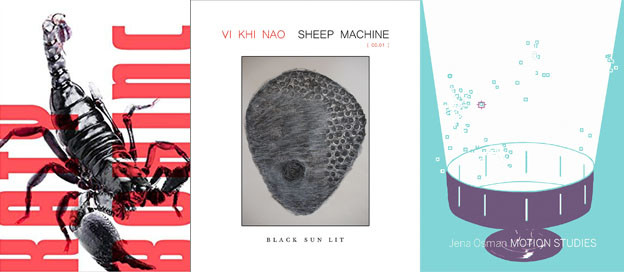
Ghostly intimacies
Orchid Tierney

Reviews editor Orchid Tierney reviews three uncanny poetry titles.
Katy Bohinc, Scorpio (Miami University Press, 2018)
Truth and logic, amour and ego, “you” and “I” all come under inventive introspection in Katy Bohinc’s Scorpio. Beautiful in its excess of music, logic, and ambiguity, Scorpio is invested in unearthing truthiness to everyday life with a capacity for loneliness and fracture. “I like being scattered in rainbows,” writes Bohinc. Elsewhere: “The recession was beautiful / In the sense that / We refrained from saying / It was ugly,” And: “We’re all projects I’m a big project / of tears.” The chanting tones of Scorpio’s poems thrust upon declarative statements. “There is nothing to be / said, but your heart’s ego to be held,” as Bohinc cants in “Chalice of Love.” “I hold you. Everything exists.”
Vi Khi Nao, Sheep Machine (Black Sun Lit, 2018)
“Is the gaze an abductee? Or an abduction?” writes Vi Khi Nao. An ekphrastic engagement with artist Leslie Thornton’s Sheep Machine, Vi Khi Naoundertakes a hauntingly kaleidoscopic gaze onto an eerie terrain of ethics, animality, and deep perception. As a timecode ticks on the page, pastoral images are made strange and incredible through the poet’s deep perceptive slants. The gazing lens of prosody grazes like sheep amongst the grass and wheat to dismantle the clarity of focus. “Time walks lowly into black apertures,” the author writes. “Keyholes, keyholes.” Vi Khi Nao’slines lull us: “Minute, minor details of an image of another image.”
Jena Osman, Motion Studies (Ugly Duckling Press, 2019)
Jena Osman’s Motion Studies is an exceptional undertaking of archival research and poetic documentary. Blending harmoniously together the networks of surveillance information, phrenology, animal studies, biopower, and media archaeology, Osman’s investigative gaze retains an adroit intensity on the afterlives of raw data that haunt us and mark nonhuman power on our bodies. Lines like “In order for the virtual to feel real, the real must be stripped of its body” and “The head is a map of self-help” underscore the extraction of sociocultural data, mediated through historical and contemporary technologies, from our bodies. “A tether. A homing device. An open-air prison,” writes Osman. “Absolute location is the world moving around you.”